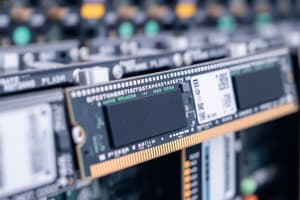Podcast
Questions and Answers
Which of the following best describes cluster computing?
Which of the following best describes cluster computing?
- A group of high-end systems connected through a single wide-area network.
- A configuration that allows for distributed resource allocation among multiple organizations.
- A system composed of heterogeneous nodes across multiple locations.
- A collection of similar systems working together in close proximity under a single management. (correct)
What characterizes grid computing compared to cluster computing?
What characterizes grid computing compared to cluster computing?
- Grid computing exclusively utilizes high-speed local area networks for connections.
- Grid computing allows for heterogeneous nodes and spans multiple organizations. (correct)
- Grid computing typically employs a master node to manage resources.
- Grid computing consists of nodes that are all located in the same physical space.
In a cluster computing model, what role does the master node typically play?
In a cluster computing model, what role does the master node typically play?
- It functions as a remote access network for the cluster.
- It serves as a compute node to process heavy calculations.
- It acts as a virtual organization for resource allocation.
- It manages the overall operation and coordination of compute nodes. (correct)
What is a crucial feature of virtual organizations within grid computing?
What is a crucial feature of virtual organizations within grid computing?
What is a primary difference between the types of networks used in cluster and grid computing?
What is a primary difference between the types of networks used in cluster and grid computing?
What is the primary function of the Fabric layer in grid computing?
What is the primary function of the Fabric layer in grid computing?
Which layer in grid computing is primarily responsible for managing a single resource?
Which layer in grid computing is primarily responsible for managing a single resource?
What is the main role of the Connectivity layer in grid computing systems?
What is the main role of the Connectivity layer in grid computing systems?
In the context of grid computing, which layer deals with collective access to resources?
In the context of grid computing, which layer deals with collective access to resources?
Which layer contains the actual grid applications used in a single organization?
Which layer contains the actual grid applications used in a single organization?
What is the primary benefit of Enterprise Application Integration (EAI)?
What is the primary benefit of Enterprise Application Integration (EAI)?
Which statement accurately describes a nested transaction?
Which statement accurately describes a nested transaction?
What does the 'ABORT TRANSACTION' command do?
What does the 'ABORT TRANSACTION' command do?
What does the Transaction Processing Monitor (TPM) primarily manage?
What does the Transaction Processing Monitor (TPM) primarily manage?
What characteristic of a transaction is described as 'durable'?
What characteristic of a transaction is described as 'durable'?
In the context of distributed transaction processing, what issue complicates transactions?
In the context of distributed transaction processing, what issue complicates transactions?
What type of system is characterized by many networked applications needing integration?
What type of system is characterized by many networked applications needing integration?
Which statement reflects the concept of 'atomic' in a transaction?
Which statement reflects the concept of 'atomic' in a transaction?
Which of the following is NOT a primitive operation in transaction processing?
Which of the following is NOT a primitive operation in transaction processing?
Which key aspect does not describe 'isolation' in transaction processing?
Which key aspect does not describe 'isolation' in transaction processing?
What is a key characteristic of nodes in sensor networks?
What is a key characteristic of nodes in sensor networks?
In which scenario do sensors process and store data?
In which scenario do sensors process and store data?
What best describes the functionality of a sensor network sending only answers to queries?
What best describes the functionality of a sensor network sending only answers to queries?
How many nodes are typically present in a sensor network?
How many nodes are typically present in a sensor network?
What is a disadvantage of using battery-powered nodes in sensor networks?
What is a disadvantage of using battery-powered nodes in sensor networks?
What is the primary function of a TP Monitor in a distributed system?
What is the primary function of a TP Monitor in a distributed system?
Which method allows for messaging without requiring both the caller and callee to be operational at the same time?
Which method allows for messaging without requiring both the caller and callee to be operational at the same time?
What is a downside of using file transfer for application integration?
What is a downside of using file transfer for application integration?
Which of the following best describes Message Oriented Middleware (MOM)?
Which of the following best describes Message Oriented Middleware (MOM)?
What is a common advantage of using a shared database for application integration?
What is a common advantage of using a shared database for application integration?
What key feature distinguishes Remote Procedure Calls (RPC) from messaging systems?
What key feature distinguishes Remote Procedure Calls (RPC) from messaging systems?
Why might a messaging approach be preferred over RPC in some situations?
Why might a messaging approach be preferred over RPC in some situations?
Which integration method poses a risk of creating performance bottlenecks?
Which integration method poses a risk of creating performance bottlenecks?
Flashcards are hidden until you start studying
Study Notes
Types of Distributed Systems
Cluster Computing
- Involves high-end systems connected via a Local Area Network (LAN).
- Typically homogeneous, sharing the same operating system and similar hardware.
- Managed by a single master node overseeing the compute nodes for efficiency.
- Local Operating Systems (OS) enable each compute node to perform parallel computations.
- High-speed networking supports standard remote access and communication.
Grid Computing
- Represents an evolution in distributed computing, connecting heterogeneous nodes across multiple organizations.
- Designed to span wide-area networks (WANs) effectively.
- Virtual organizations facilitate collaboration by grouping user IDs for resource allocation authorization.
Architecture for Grid Computing
- Fabric Layer: Interfaces with local resources, responsible for querying states and capabilities.
- Resource Layer: Manages individual resources, overseeing tasks like process creation and data reading.
- Connectivity Layer: Provides communication protocols for data transfer among resources and handles authentication.
- Collective Layer: Manages access to multiple resources, focusing on discovery, scheduling, and data replication.
- Application Layer: Hosts grid applications relevant to the organization.
Distributed Information Systems
Integrating Applications
- Organizations face challenges in achieving interoperability among various networked applications.
- Integration involves clients combining requests from different applications, collecting responses, and presenting a unified result.
- Direct application-to-application communication leads to Enterprise Application Integration (EAI).
EAI: Transactions
- BEGIN TRANSACTION: Initiates a transaction process.
- END TRANSACTION: Completes the transaction and attempts to commit changes.
- ABORT TRANSACTION: Cancels the transaction and restores prior values.
- READ/WRITE Operations: Involves data retrieval and storage from/to files or databases.
- All-or-nothing property essential for nested transactions maintains atomicity, consistency, isolation, and durability.
Transaction Processing Monitor (TPM)
- Coordinates transactions affecting data distributed across various servers.
- Ensures that requests from clients are properly managed and executed by the TP monitor.
Middleware and EAI
- Communication Middleware: Facilitates integration through servers and clients communicating effectively.
- Remote Procedure Call (RPC): Allows requests to be processed as messages, with results returned like typical procedure calls.
- Message-Oriented Middleware (MOM): Sends messages to a logical contact point, forwarding to subscribed applications.
Integration Methods
- File Transfer: Easy but lacks flexibility; requires knowledge of file formats and management.
- Shared Database: More flexible but prone to bottlenecks and requires a common data scheme.
- Remote Procedure Call: Suitable for executing sequences of actions.
- Messaging: Decouples communication in time and space, enhancing reliability and flexibility.
Pervasive Systems: Sensor Networks
- Characterized by numerous simple nodes (10s to 1000s) with low memory and computational power.
- Often powered by batteries, or even battery-less, highlighting their energy-efficient design.
- Can operate as distributed databases, with two models for processing and data management:
- Direct Data Transfer: Sensors send unprocessed data to an operator's site.
- Query-Response Model: Sensors respond only to specific data requests, streamlining data handling.
Studying That Suits You
Use AI to generate personalized quizzes and flashcards to suit your learning preferences.




